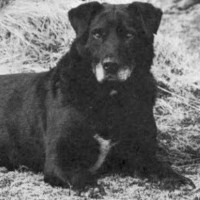 |
St. John's Water Dog |
|
He is not recognized by the F.C.I. |
Origin |
Canada | |
Translation |
Francis Vandersteen |
| The St. John's Water Dog, also known as the St. John's Dog or Lesser Newfoundland, was a country breed (a dog bred for a specific purpose, not for looks) of Newfoundland domestic dog. Little is known about the types that went into its genetic make-up, although it was probably a random mix of old English, Irish and Portuguese working dogs. They were the preferred dogs of fishermen, as they possessed extraordinary qualities such as good temperament and good working behavior. The number of St. John's Water Dogs began to decline in the early 20th century. By the early 1980s, the breed had become extinct. The St. John's Water Dog was the ancestor of modern retrievers, including the Flat Coated Retriever, Curly Coated Retriever, Chesapeake Bay Retriever, Golden Retriever and Labrador Retriever. They were also called water dogs because of their love of water and water-resistant coat. The St. John's dog was also an ancestor of the large, gentle Newfoundland dog, probably through breeding with mastiffs brought to the island by generations of Portuguese fishermen who had been fishing offshore since the 15th century. In the 19th and early 20th centuries, St. John's dogs were exported from Newfoundland to England. These dogs were crossed with other dogs to create retrievers. St. John's Water Dogs were medium-sized, powerful and stocky, more like modern English Labradors than American Labs. They had characteristic white patches on the chest, chin, feet and muzzle. This coloration sometimes appears in modern Labradors as a small white patch on the chest, called a "medallion", or a few white hairs on the feet. The classic tuxedo markings of the St. John's Water Dog are commonly seen in Labrador Retriever mixes. As far back as the 17th century, writings mention sturdy medium-sized black dogs that accompanied Newfoundland fishermen in their boats, retrieving fish fillets and carrying them back to the ship. The dogs were described as having short, thick coats, rudder-like tails, great endurance and a great love of swimming. In his book Excursions around Newfoundland during the years 1839 and 1840, vol. 1, geologist Joseph Beete Jukes describes the St. John's water dog with puzzled admiration: "A lean, short-haired black dog came to sea today. The animal was of a breed very like the Newfoundland and different from what we mean by English dog in England. It had a fine, tapering muzzle, a long slender tail and rather slender but powerful legs, with a lean body and short, smooth hair," Jukes writes. "These are the most abundant dogs in the country ... They are not beautiful, but are generally more intelligent and useful than the others ... I noticed that once or twice he put his foot in the water and paddled on it. The foot was white, and Harvey said he did it to attract fish. The whole procedure struck me as remarkable, especially since they claimed he'd never learned anything like it. The St. John's Water Dog became extinct in its homeland through a combination of two factors. To encourage sheep farming, heavy restrictions and taxes were placed on dog ownership in the 19th century. The UK, their main overseas destination, also imposed strict long-term quarantine on all imported animals, particularly dogs (1885), as part of the eradication of rabies. However, in Newfoundland and the Maritime provinces, there are still large black dogs of mixed breed with many characteristics of the original St. John's water dog. The last two known St. John's Water Dogs were photographed in the early 1980s (at an advanced age) after surviving in a "very remote area", but they were both male, thus ending the St. John's Water Dog. In the 1970s, Canadian author Farley Mowat had tried to save them by crossing his St. John's water dog, named "Albert", with a Labrador Retriever. Four puppies resulted, all with their sire's distinctive white markings. Two puppies died, the other two were given away. One was given to Canadian Prime Minister Pierre Trudeau and the other to Soviet Prime Minister Alexei Kosygin. In 1970, Mowat and Albert appeared in an episode of the TV series Telescope. |






 English (United Kingdom)
English (United Kingdom)